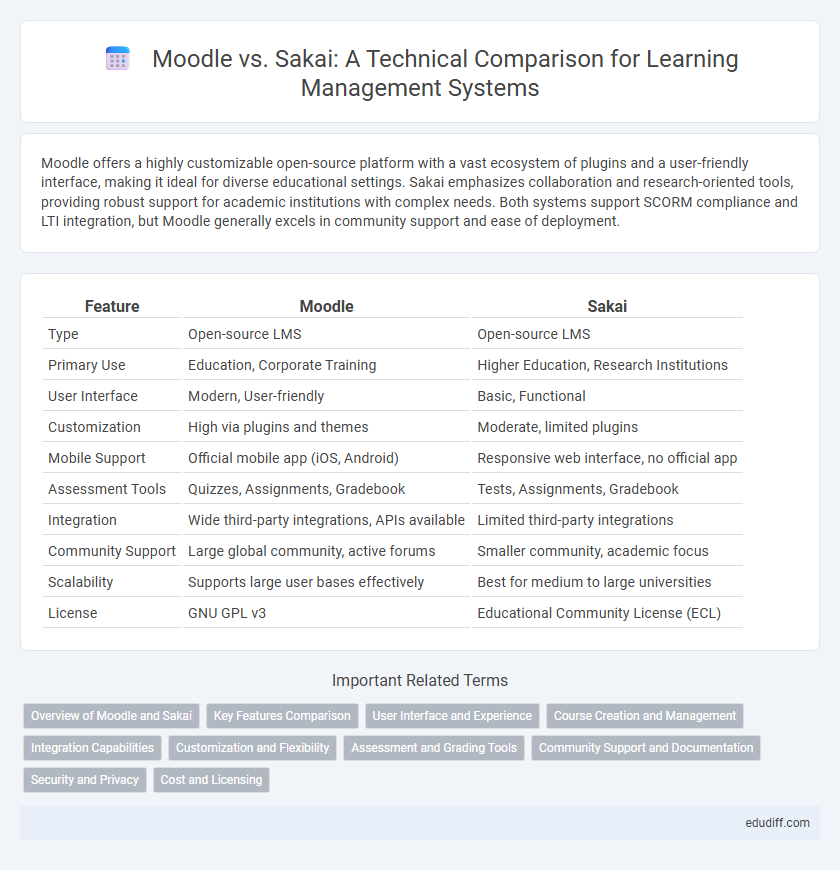Moodle offers a highly customizable open-source platform with a vast ecosystem of plugins and a user-friendly interface, making it ideal for diverse educational settings. Sakai emphasizes collaboration and research-oriented tools, providing robust support for academic institutions with complex needs. Both systems support SCORM compliance and LTI integration, but Moodle generally excels in community support and ease of deployment.
Table of Comparison
| Feature | Moodle | Sakai |
|---|---|---|
| Type | Open-source LMS | Open-source LMS |
| Primary Use | Education, Corporate Training | Higher Education, Research Institutions |
| User Interface | Modern, User-friendly | Basic, Functional |
| Customization | High via plugins and themes | Moderate, limited plugins |
| Mobile Support | Official mobile app (iOS, Android) | Responsive web interface, no official app |
| Assessment Tools | Quizzes, Assignments, Gradebook | Tests, Assignments, Gradebook |
| Integration | Wide third-party integrations, APIs available | Limited third-party integrations |
| Community Support | Large global community, active forums | Smaller community, academic focus |
| Scalability | Supports large user bases effectively | Best for medium to large universities |
| License | GNU GPL v3 | Educational Community License (ECL) |
Overview of Moodle and Sakai
Moodle, an open-source learning management system (LMS), offers extensive customization, a large plugin ecosystem, and a user-friendly interface designed for educators and institutions worldwide. Sakai, also an open-source LMS, emphasizes collaborative learning, robust assessment tools, and adaptability for research-intensive environments, making it popular among higher education institutions. Both platforms support scalable online course delivery but differ in community support and integration capabilities.
Key Features Comparison
Moodle offers a robust set of key features including customizable course creation, a wide range of plugins, and advanced analytics for tracking learner progress, making it highly adaptable for diverse educational needs. Sakai emphasizes collaborative tools such as integrated forums, assignment management, and group projects with a strong focus on open-source flexibility and community-driven development. Both platforms support mobile access, assessment tools, and grading workflows, but Moodle leads in user interface customization and extensive third-party integrations.
User Interface and Experience
Moodle offers a highly customizable user interface with a wide range of plugins, enabling institutions to tailor the learning environment to specific needs, while its intuitive dashboard enhances user experience by simplifying navigation. Sakai provides a clean and minimalistic interface optimized for consistency and ease of use, but its limited customization options may restrict personalization compared to Moodle. Both platforms support responsive design, though Moodle's extensive theme library typically results in a more engaging and adaptable user experience across devices.
Course Creation and Management
Moodle offers a robust course creation interface with customizable templates, modular activity resources, and extensive third-party plugin support, enabling educators to tailor learning paths efficiently. Sakai provides flexible course management tools with built-in assessment features and collaborative workspaces, supporting real-time interactions and resource sharing across user groups. Both platforms emphasize scalable user management and integrated analytics, but Moodle's expansive ecosystem often delivers broader customization for diverse educational needs.
Integration Capabilities
Moodle offers extensive integration capabilities through its vast plugin ecosystem, supporting seamless connections with third-party tools such as Google Workspace, Microsoft Office 365, and various LTI-compliant applications. Sakai provides robust integration features as well, with strong support for standards like LTI and SCORM, enabling compatibility with enterprise systems and educational tools. Both platforms prioritize interoperability, but Moodle's larger community often results in more frequent updates and a broader range of integration options for diverse educational and administrative functions.
Customization and Flexibility
Moodle offers extensive customization options through a vast library of plugins and themes, enabling educators to tailor the platform to specific learning needs and institutional requirements. Sakai provides flexible course design features with a strong focus on interoperability and open-source collaboration, allowing seamless integration with diverse academic tools. Both platforms support scalable customization, but Moodle's larger community contributes to quicker development and deployment of new functionalities.
Assessment and Grading Tools
Moodle offers a comprehensive suite of assessment and grading tools, including quizzes, assignments, and rubrics that support various question types and automated grading. Sakai provides robust assessment features with customizable grading frameworks, peer assessments, and integration with external tools for enhanced evaluation. Both platforms support gradebook functionalities with detailed reporting and analytics, but Moodle's extensive plugin ecosystem offers more flexibility for tailored assessment solutions.
Community Support and Documentation
Moodle boasts a vast, active global community with comprehensive forums, user groups, and regular updates, ensuring extensive peer-driven support and continuously evolving documentation. Sakai's community, while smaller, offers focused collaboration primarily among higher education institutions, providing specialized resources and detailed technical documentation tailored to academic needs. The breadth and diversity of Moodle's community support generally surpass Sakai's, making it more accessible for diverse user groups seeking extensive documentation and troubleshooting resources.
Security and Privacy
Moodle offers advanced security features such as data encryption, regular security audits, and compliance with GDPR to safeguard user information, making it a preferred choice for institutions prioritizing privacy. Sakai emphasizes robust access controls and decentralized hosting options, allowing organizations to maintain greater control over their data privacy and meet specific institutional security policies. Both platforms provide customizable security settings, but Moodle's extensive community support ensures quicker updates and patches for emerging vulnerabilities.
Cost and Licensing
Moodle operates on an open-source GPL license, requiring only hosting and maintenance expenses, making it cost-effective for institutions with in-house technical expertise. Sakai also offers a free open-source license but often incurs higher implementation costs due to a smaller developer community and fewer pre-built integrations. Choosing between Moodle and Sakai depends largely on the available budget for technical support and the total cost of ownership for deployment and customization.
Moodle vs Sakai Infographic

 edudiff.com
edudiff.com